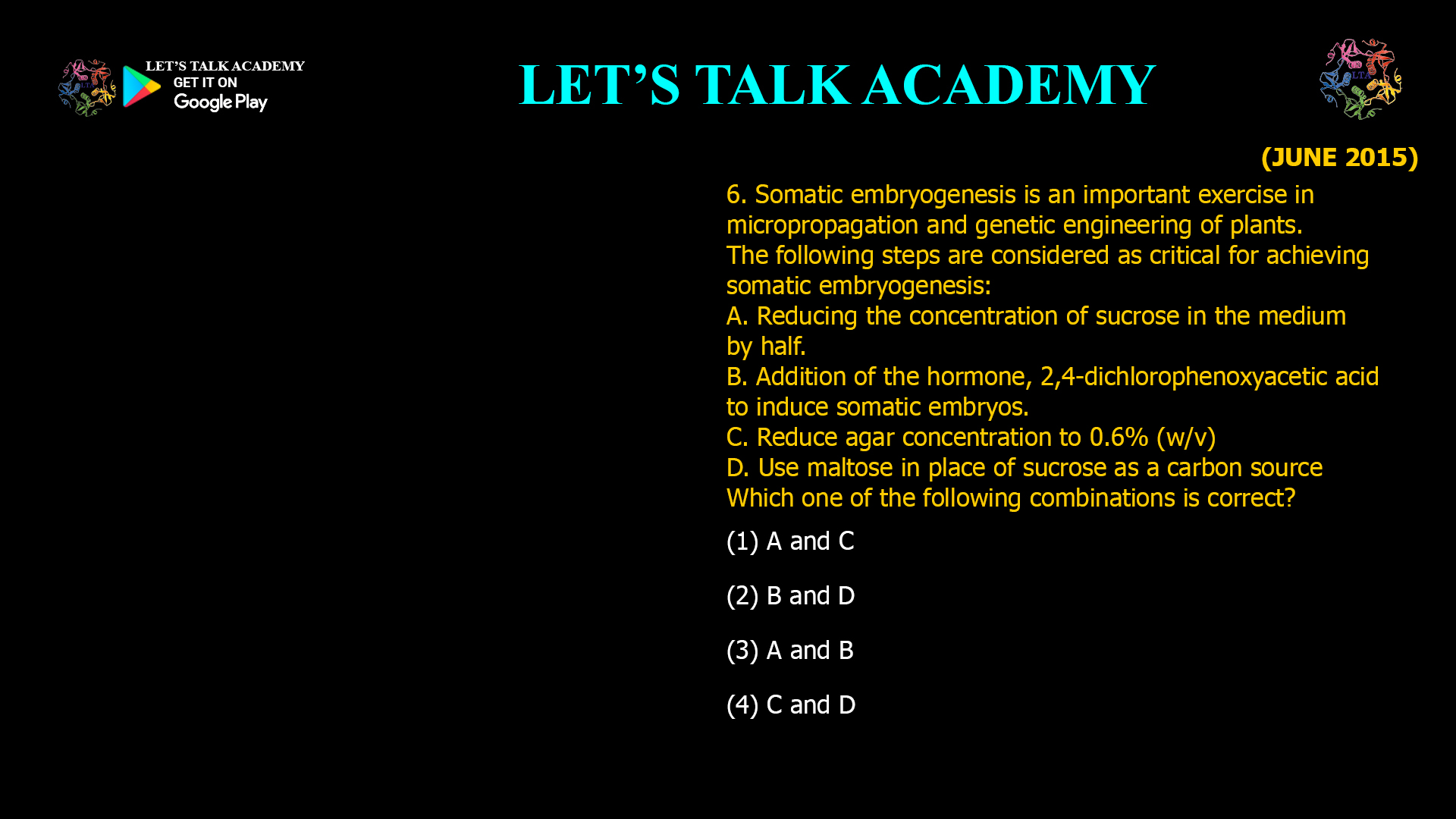- Somatic embryogenesis is an important exercise in micropropagation and genetic engineering of plants. The following steps are considered as critical for achieving somatic embryogenesis:
A. Reducing the concentration of sucrose in the medium by half.
B. Addition of the hormone, 2,4-dichlorophenoxyacetic acid to induce somatic embryos.
C. Reduce agar concentration to 0.6% (w/v)
D. Use maltose in place of sucrose as a carbon source
Which one of the following combinations is correct?
(1) A and C (2) B and D
(3) A and B (4) C and DWhy B is correct: 2,4‑D to induce somatic embryos
Auxin 2,4‑dichlorophenoxyacetic acid (2,4‑D) is one of the most widely used plant growth regulators for inducing embryogenic callus and triggering somatic embryogenesis. At appropriate concentrations, 2,4‑D acts as a strong stressor and auxinic signal that reprograms somatic cells into an embryogenic state, often yielding high percentages of embryogenic callus and somatic embryos in numerous species such as rice, barley, and many dicots. Therefore statement B is a critical, well-supported step.
Why D is correct: maltose instead of sucrose
Many studies show that maltose is superior to sucrose as a carbon source for somatic embryogenesis, improving embryogenic callus induction, embryo number, uniformity and morphology. Maltose often slows callus growth but enhances acquisition of embryogenic characteristics and reduces browning, thereby increasing somatic embryo yield and quality. Hence using maltose in place of sucrose (statement D) is recognized as an important medium modification for somatic embryogenesis.
Why A is not a critical step
A. Reducing sucrose concentration by half
-
Somatic embryogenesis can respond to osmotic or nutritional stress, and various sucrose levels have been tested, but no single rule states that “reducing sucrose by half” is a universally critical step.
-
In many protocols, higher carbohydrate (or combined sucrose+maltose) levels or specific molar concentrations, not an arbitrary 50% reduction, are beneficial for embryo induction or maturation.
Thus A is not a general defining requirement.
Why C is not a critical step
C. Reduce agar concentration to 0.6% (w/v)
-
Agar concentration affects gel strength and water availability, but standard plant tissue culture already uses around 0.7–0.8% agar; adjusting it to 0.6% is a physical optimization, not a hallmark trigger of somatic embryogenesis.
-
Somatic embryo induction is primarily governed by growth regulators and carbon sources, not by a specific agar percentage like 0.6%. Therefore C is not considered a core critical step.
Option-by-option evaluation
-
(1) A and C – Both relate to medium texture or osmotic effects, but neither is a universally critical trigger; this option ignores the central roles of 2,4‑D and maltose.
-
(2) B and D – Correct; both 2,4‑D addition and maltose substitution are repeatedly reported as key for inducing embryogenic callus and somatic embryos.
-
(3) A and B – Includes 2,4‑D (good) but couples it with a non‑essential, protocol‑specific sucrose reduction rather than the more critical maltose substitution.
-
(4) C and D – Contains maltose (good) but omits 2,4‑D, which is central to auxin‑induced somatic embryogenesis in most systems.
SEO‑oriented introduction (for article use)
Somatic embryogenesis is a powerful tool in plant micropropagation and genetic engineering, and its success depends heavily on culture medium composition. Numerous studies demonstrate that adding the synthetic auxin 2,4‑D and replacing sucrose with maltose create the hormonal and nutritional conditions needed to reprogram callus cells into somatic embryos, whereas simple adjustments of sucrose or agar concentration alone are not consistently critical steps.
-



